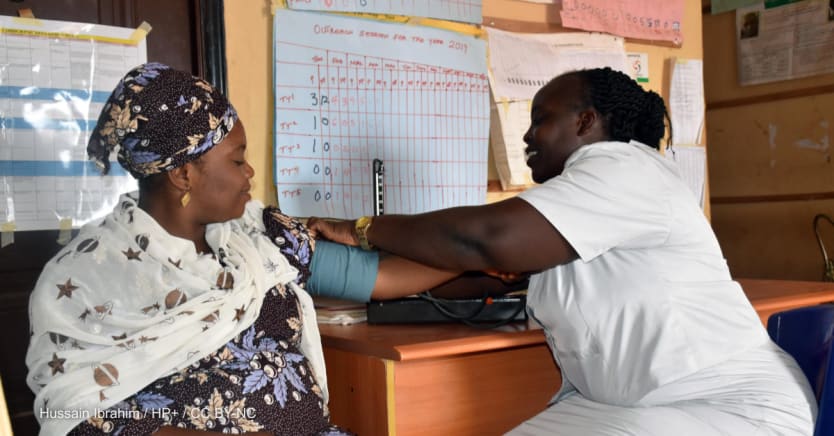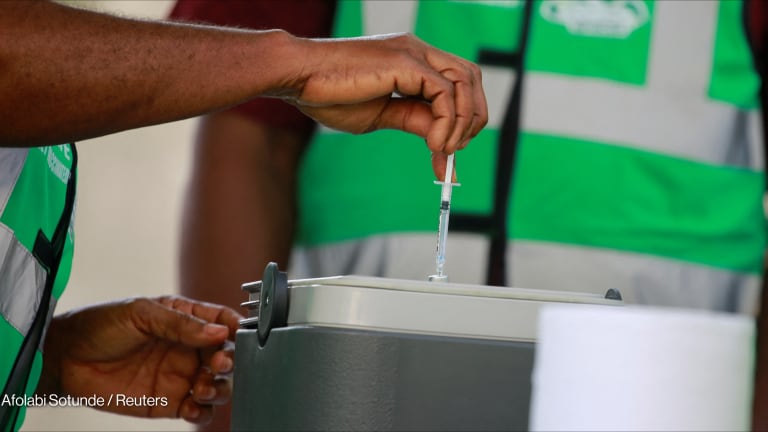
COVID-19 has highlighted the need for resilient health systems by exposing how fragmented they are, with 90% of 105 surveyed countries reporting disruptions to essential health services during the pandemic.
Even before the outbreak, half of the world’s population lacked access to such services, and slowdowns were reported in the pace of progress on universal health coverage, or UHC — a target under Sustainable Development Goal 3 on ensuring health and well-being for all by 2030. Now, financial straitjackets imposed by COVID-19 amid economic downturns could further challenge advances on UHC.
Yet there are hopes that countries and donors will see adverse health impacts as a reason to galvanize efforts, with promise shown in the wake of increased public spending in countries such as Sierra Leone, Guinea, and Liberia after the 2014-16 Ebola crisis.
“Many have advocated the need to speed implementation of UHC and build resilient health systems as a strategy to address the current and potential future pandemic(s),” according to a recent analysis by the Center for Global Development.
Where UHC can be achieved — through a combination of refocusing on robust primary health care and getting a trained, paid, and equipped health workforce out to communities to bolster access and trust — there will be much greater resilience for future pandemics, said Kim Green, global program director for the primary health care program at nonprofit PATH.
Primary focus
“We believe that investing in primary health care is the expressway for universal health coverage,” Green said. “When there’s integration of disease surveillance and pandemic response within primary health care, then we’re best protected against current and future outbreaks.”
She highlighted that primary health accounts for 80% of people’s lifetime care needs, yet it receives only about 40% of the health budget in many countries.
“Righting that allocation of existing resources would make a tremendous difference,” she said. “The key thing is that the health system is not only able to absorb the shock of an immediate outbreak, but they’re also able to maintain their core functions.”
“If we can invest in community health services, then we will, in the long run, save [money].”
— Patricia Nudi Orawo, advocacy and policy lead, Kisumu Medical and Education TrustThis includes continuing to support noncommunicable diseases, or NCDs, such as diabetes, especially as those with underlying conditions are at higher risk of severe complications from diseases like COVID-19. While NCDs account for 71% of global deaths, they receive less than 2% of global health funding.
Green also said there is more need for robust supply chains and “adaptive responses” such as multimonth prescriptions for the management of chronic diseases when lockdowns or restrictions on movement might be in place.
Virtual training for workforces dealing with NCDs presents a further opportunity, she added. “When you’re able to offer telemedicine, you’re able to reach many more people and in a very targeted and precise way.”
Digital health company Babylon recently signed a 10-year contract with the Rwandan government to support a “digital-first approach” to universal primary care, including the widespread rollout of its cellphone-based service Babyl across the country and the incorporation of electronic medical records to improve record-keeping and information-sharing, as well as to cut costs.
Kenyan drive
Kenyan policymakers have been “rallying around COVID-19 as a rationale for investing in or scaling UHC,” allowing the country to continue focusing on the goal, Green said.
In October, the government outlined plans for expanding UHC, following a pilot in four of the country’s 47 counties. This saw more than 1.6 million additional hospital visits within a year and provided a basis for boosting resource capacity during the pandemic, as well as the establishment of an additional 208 community health units.
Patricia Nudi Orawo, advocacy and policy lead at the Kisumu Medical and Education Trust, or KMET, called for continued devolution from clinics to households to shift the focus from treating symptoms to prevention. “Health care is not bricks and mortar; health care is what we do every single day,” she said.
Kenya has invested a large amount in treating conditions such as malaria, diarrhea, and respiratory infections, but their prevalence can be significantly reduced through basic personal means such as mosquito nets, hand-washing, and good ventilation, according to Nudi Orawo.
That’s where community health workers, or CHWs, can come in, providing information on how to manage these illnesses. “It’s a smart buy,” she said. “If we can invest in community health services, then we will, in the long run, save [money].”
But while she said progress has been made on expanding health to the community, there are still major gaps in areas such as sexual and reproductive health and rights.
A lack of women in elected positions leads to “narrow” ideas about their needs, said Nudi Orawo, noting a lack of education about family planning or danger signs in pregnancy. This means there is “a long way to go” in addressing this issue across the country, even though KMET’s advocacy recently helped secure hundreds of thousands of U.S. dollars for reproductive, maternal, newborn, child, and adolescent health, and it is pushing initiatives to aid inclusion of family planning in UHC.
“What we have is an opportunity to prevent the next pandemic by setting up programs that are human-centered.”
— James Nardella, chief program officer, Last Mile HealthReaching the ‘last mile’
James Nardella, chief program officer at NGO Last Mile Health, said he is hopeful that COVID-19 can galvanize efforts toward CHW-backed primary health care, a strategy he said has proven effective in Liberia.
In the wake of Ebola, Liberia carried out reforms and, along with donors and NGOs such as Last Mile Health, expanded CHWs’ reach and systems to support them.
With only a few weeks of training on treating preventable diseases and screening for malnutrition and NCDs, much work can be moved to community-based primary care, while also creating paid jobs, said Nardella. “We want to see community health worker programs formally institutionalized within government systems.”
COVID-19 has revealed how CHWs can become the front-line force needed to maintain essential health services, as well as to tackle vaccine hesitancy and other issues that require trust. The question now, Nardella said, is how these programs can be further incorporated as governments are thinking about their post-COVID-19 response.
A major challenge is to sustain programs in the long term, with the need for “Big Aid” and philanthropy to “continue to prioritize community-based primary care and not just focus on a disease vertical.”
Nardella said he hopes that with the $11 billion recently approved by the United States for global pandemic response, for example, there is an opportunity to direct more resources to boosting the use of CHWs to maintain essential health services.
Being realistic
The goals of UHC should be reinforced within new budget constraints, targeting funding at the best value-for-money intervention, according to Y-Ling Chi, senior policy analyst at CGD.
In Brief: US COVID-19 bill includes over $11B for global pandemic relief
The U.S. House of Representatives passed a $1.9 trillion COVID-19 relief bill. Here's the rundown on what global funding was included.
She highlighted a need to harness the widespread COVID-19 facilities and networks created during the pandemic rather than letting them fall by the wayside and to use these to test for conditions such as NCDs, HIV, or tuberculosis.
Benin, for example, went from having just one facility capable of testing for COVID-19 to 13 across the country in 2020, with hopes of expanding the labs’ capabilities to test for other diseases and participate in global flu surveillance.
Chi added that the current time may call for being “politically brave” by applying a long-term, stage-by-stage approach for resilience, even though that may not be headline-grabbing.
Ultimately, according to Nardella, countries that can establish properly trained, supervised, and paid cadres of CHWs for various diseases will be best placed to deal with future pandemics — as seen in Liberia, where CHWs were able to continue the delivery of treatments for pneumonia, malaria, and diarrhea even during the COVID-19 pandemic. “Those places that were pre-positioned have been able to maintain essential health services,” he said.
“What we have is an opportunity to prevent the next pandemic by setting up programs that are human-centered,” he said.
Visit the Building Back Health series for more coverage on how we can build back health systems that are more effective, more effective, equitable, and preventive. You can join the conversation using the hashtag #BuildBackHealth.









